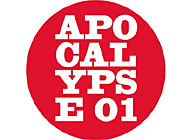Red Cross Museum highlights Apocalypse Then – and Now

Henri Dunant is best known as founder of the Red Cross movement, but in his latter years, he became convinced the world was about to end. An exhibition at Geneva's Red Cross Museum illustrates Dunant's and mankind's preoccupation with the Apocalypse.
The exhibition is entitled Apocalypse 01, as it marks the 100th anniversary of Dunant receiving the first ever Nobel Peace Prize.
Its centrepiece comprises four fascinating diagrams drawn by Dunant, outlining his prophetic concept of history. They are supplemented by scenes from classic films, which, like Dunant’s drawings, predict the end of the world.
“To most people, Dunant is the founder of the Red Cross and nothing more. But these diagrams show that he was a man of faith,” says Roger Mayou, director of the museum.
Towards the end of his life, Dunant lived a reclusive and contemplative existence in Heiden, in canton Appenzell. He devoted much of his time to rereading the Bible, and became fascinated by the Book of Daniel and the Apocalypse.
“He was a very complex character. With his particular experience of war, he was certain that the world was about to end,” says Philippe Mathez, curator of the exhibition.
Dunant’s was a member of a Protestant movement called the Awakening, and believed the Apocalypse would be a positive thing: “He was convinced that after this Apocalypse, there would be a new world – a world of peace,” Mathez told swissinfo.
The four drawings are in a kind of Naïve Art style. Dunant used them to illustrate his vision to his friends.
They were done on paper and are very fragile. The museum only acquired them last year, and once the exhibition ends in November, they will be returned to storage.
The themes of the four drawings are echoed in the film clips which are shown in a loop on 20 television sets. All deal with the end of the world, but are divided into five different ways for the Earth to meet its end: destruction from outer space, technology, war, nuclear annihilation and the revenge of nature.
Among the classic movies are Metropolis, Godzilla, Dr Strangelove, the Birds and It Came from Outer Space.
“The films show that the ideas behind science fiction were not that distant from Dunant’s vision. It was only the context that was different,” says Mathez.
He says that these films “take an ambivalent attitude towards the apocalypse. They seem to be warning us of mankind’s destruction, while at the same time holding out a promise of renewal, in some cases even offering hope for a bright future.”
by Roy Probert

In compliance with the JTI standards
More: SWI swissinfo.ch certified by the Journalism Trust Initiative
You can find an overview of ongoing debates with our journalists here. Please join us!
If you want to start a conversation about a topic raised in this article or want to report factual errors, email us at english@swissinfo.ch.